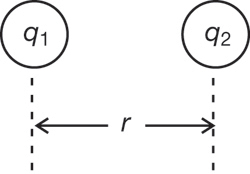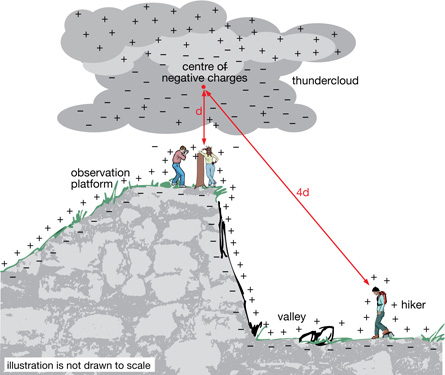Module 3
1. Module 3
1.15. Page 6
Module 3—Electrical Phenomena
 Reflect and Connect
Reflect and Connect
The conclusions of Coulomb’s experimental work with the torsion balance enabled him to describe the factors that determined the magnitude of the electrostatic force.



© NOAA US Gov
Coulomb’s law: the magnitude of the electrostatic force between two charged objects is directly proportional to the product of the two charges on the objects and inversely proportional to the square of the distance of separation between their centres.
Coulomb’s law can provide insights into the circumstances described in the Get Focused section.

 Try This
Try This
TR 4. Recall your work from Lesson 1. Describe the process that caused the top surfaces of the objects under the thundercloud to develop a positive charge.
TR 5. The circumstances in this illustration are much more complex than the carefully controlled environment of Coulomb’s experiment. Identify at least two differences between the circumstances in the illustration and Coulomb’s work.
The answers to the previous question indicate that applying Coulomb’s law to the circumstances in the illustration will only yield a rough approximation of what may be occurring in terms of electrostatic forces.
Even with these limitations in mind, some valuable insights can be gained into lightning safety.
 Self-Check
Self-Check
SC 18. The illustration shows that the hiker is four times farther from the negative charges in the thundercloud than the people on the observation platform.
- Use Coulomb’s law to provide a rough comparison of the electrostatic force that would act on a similarly charged strand of hair in each location.
- Do you think it is reasonable to assume that a strand of hair would have a similar charge in each location? Explain concisely.
- How does your answer to SC 18.b. affect your estimates of forces in SC 18.a.?
 Self-Check Answers
Self-Check Answers
SC 18.
- Assuming that the strands of hair in both locations are similarly charged means that distance would be the only difference. Since the distance is four times farther for the hiker, the resulting electrostatic force acting on a strand of hair would be only
 th as much for the hiker. This is because the inverse square of a fourfold increase is (
th as much for the hiker. This is because the inverse square of a fourfold increase is ( )2 or
)2 or  .
.
- No, it is not reasonable to assume that the strands of hair would have similar charges in each location. The induced charge on a strand of hair for the hiker would be less due to the larger distance of separation between the hair strand and the cloud.
- If a strand of hair on the head of the hiker had a smaller induced charge, then the resulting electrostatic force exerted by the charges in the cloud would be even less than the estimate from SC 18.a.
 Big Picture Reflection
Big Picture Reflection

Imagine you are out hiking and are surprised by a sudden thunderstorm. Based on Coulomb’s law, what are the strategies for protecting yourself?
The strategies are:
- Avoid high spots, or very open areas; look for low areas.
- Sit down in a tucked position to get further from the clouds and prevent charge build up on extremities (arms, head and legs).
- Wear and/or sit on some insulating plastic, if possible.
- Get rid of metal objects that could conduct electric charges.
- Close your eyes and cover your ears to protect yourself from any nearby lightning strikes.
Does Coulomb’s law validate the recommendations shown in this illustration?
Store your thoughts in your Physics 30 course folder.
 Module 3: Lesson 2 Assignment
Module 3: Lesson 2 Assignment
Remember to submit your Module 3: Lesson 2 Assignment to your teacher for marks. If you are not familiar with curve straightening refer back to Self Check 13 for an example.
A 1. Answer questions 25. a., b., c., and d. on page 541 of your textbook.
A 2. A student is investigating Coulomb’s law. The student measures a force of +2.00 × 10−3 N between the two charged spheres.
- Explain how you can tell whether the charges are both positive, both negative, or positive and negative.
- Describe two methods that the student could use to increase the force to 64 times its current value.
- The student touches one of the spheres with an equally sized neutral sphere and then removes the neutral sphere. The student then moves one of the spheres so the distance is three times the original distance. What is the ratio of the original force to the new force?